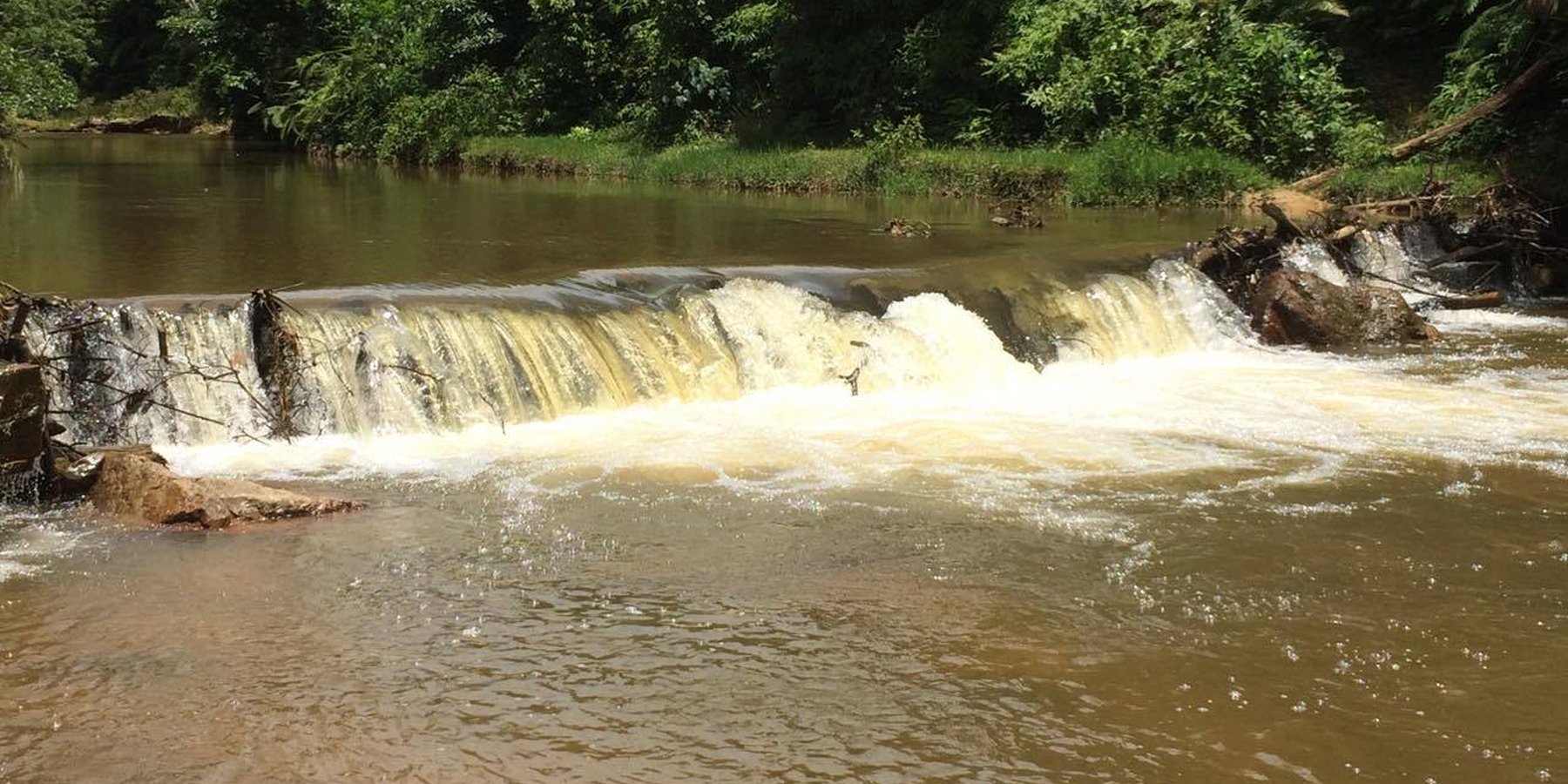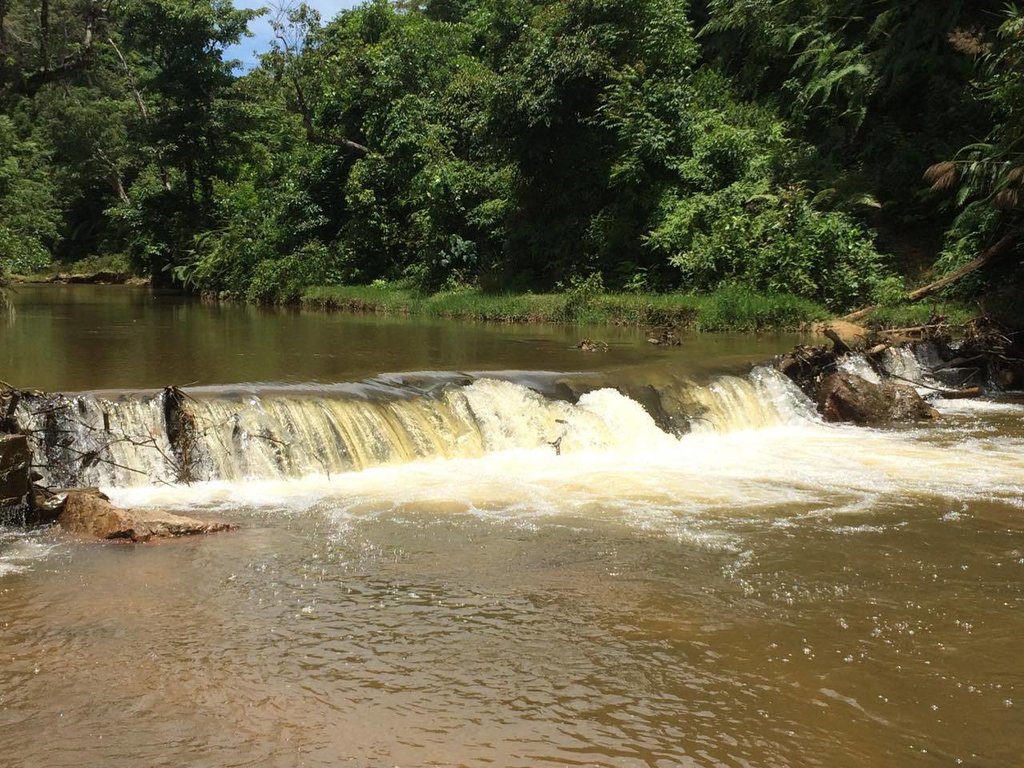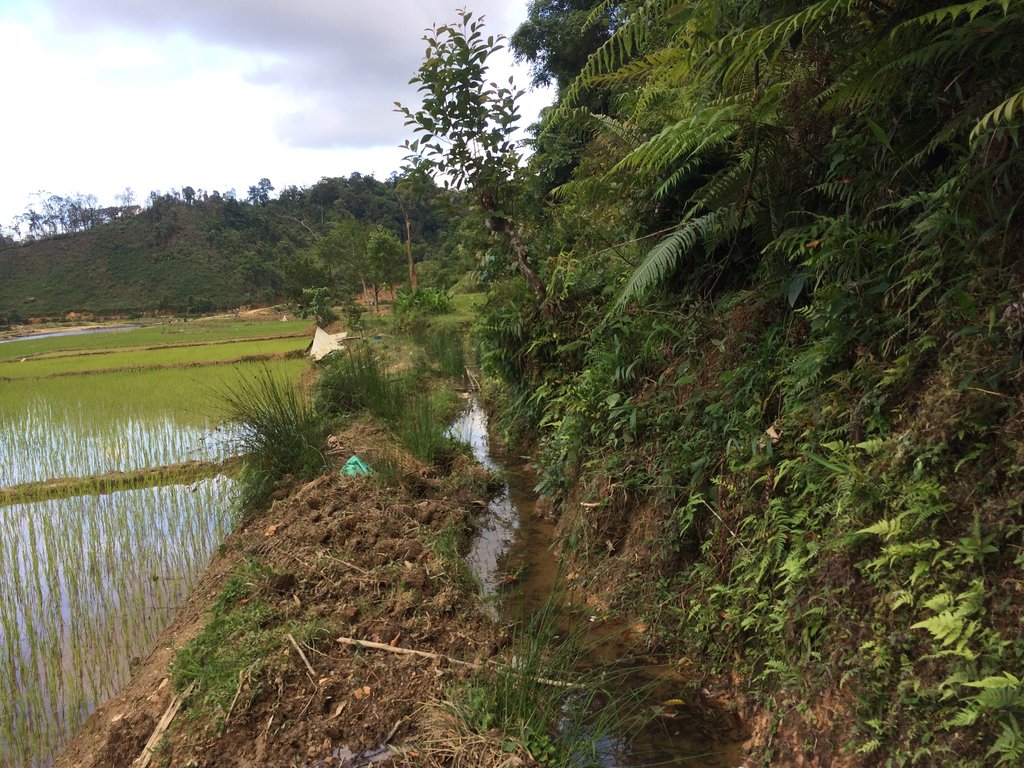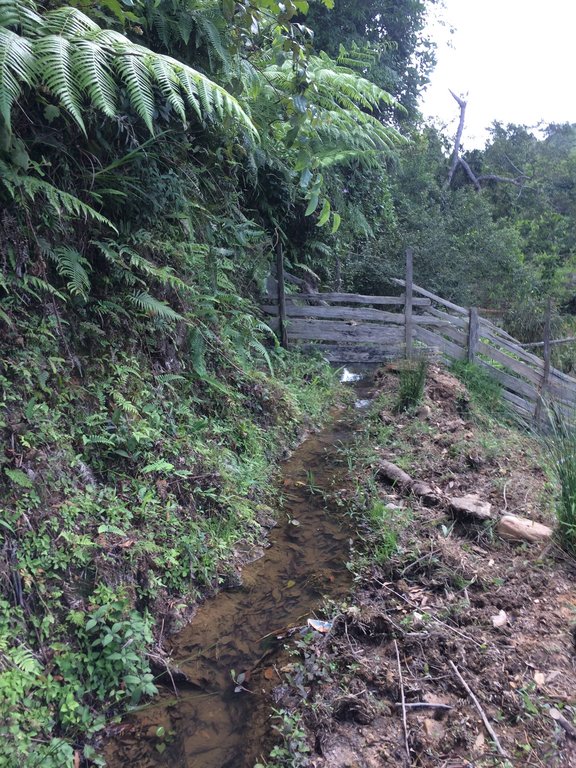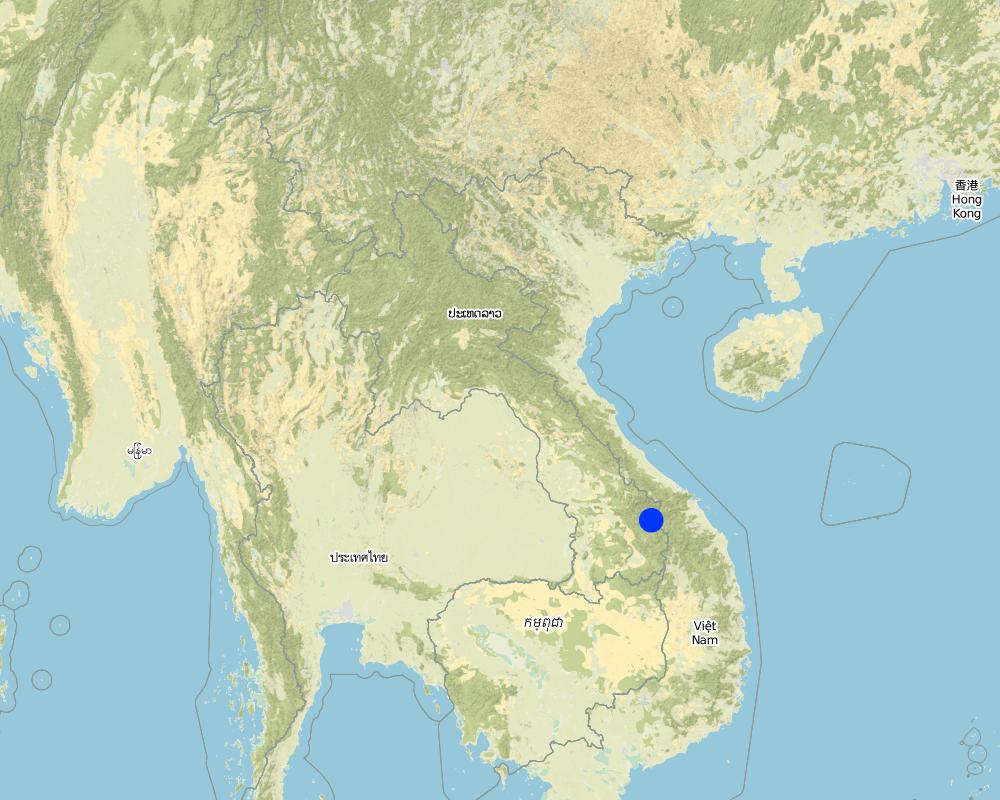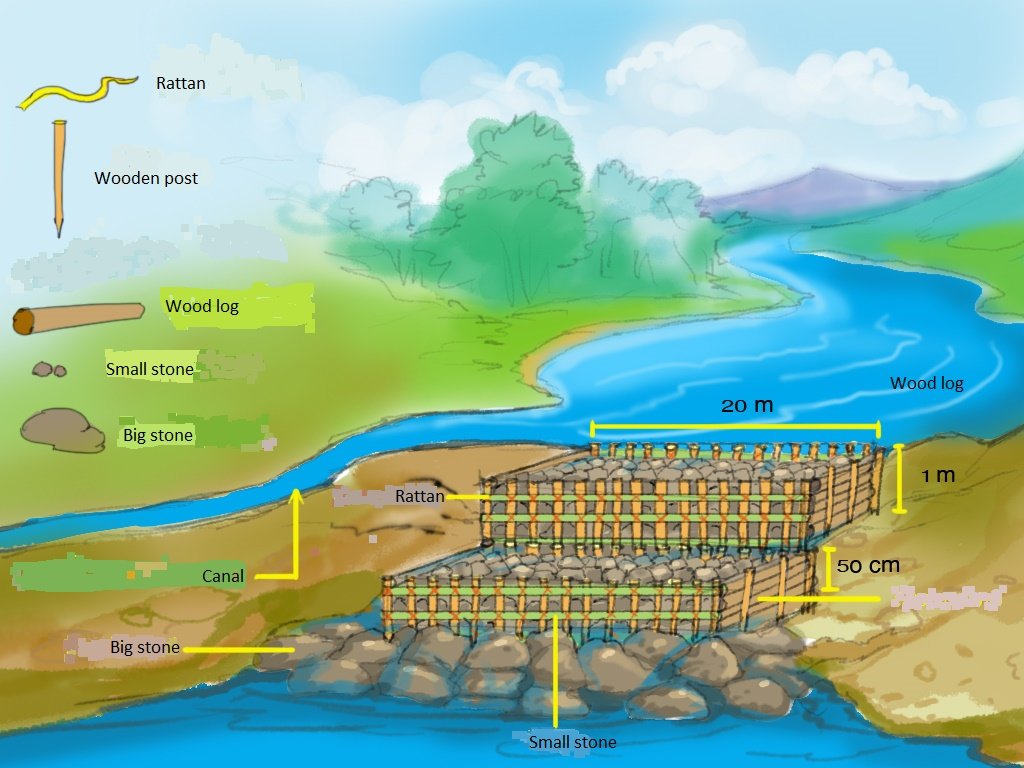Local indigenous dyke for water harvesting [老挝人民民主共和国]
- 创建:
- 更新:
- 编制者: kang phanvongsa
- 编辑者: Pasalath Khounsy, Bounthanom Bouahom, anousit namsena
- 审查者: viengsavanh phimphachanhvongsod, Stephanie Jaquet, Nicole Harari
technologies_2306 - 老挝人民民主共和国
查看章节
全部展开 全部收起1. 一般信息
1.2 参与该技术评估和文件编制的资源人员和机构的联系方式
关键资源人
土地使用者:
Sengmany
02096124255
Tangnong village, Dakchaung district, Sekong province
老挝人民民主共和国
土地使用者:
Sekhamphone Yangmao
0309946972
Tangnong village, Dakchaung district, Sekong province
老挝人民民主共和国
SLM专业人员:
有助于对技术进行记录/评估的项目名称(如相关)
Scaling-up SLM practices by smallholder farmers (IFAD)有助于对技术进行记录/评估的机构名称(如相关)
National Agriculture and Forestry Research Institute (NAFRI) - 老挝人民民主共和国1.3 关于使用通过WOCAT记录的数据的条件
(现场)数据是什么时候汇编的?:
11/05/2017
编制者和关键资源人员接受有关使用通过WOCAT记录数据的条件。:
是
1.4 所述技术的可持续性声明
这里所描述的技术在土地退化方面是否存在问题,导致无法被认为是一种可持续的土地管理技术?:
否
2. SLM技术的说明
2.1 技术简介
技术定义:
A Local Indigenous Weir to Harness Water
2.2 技术的详细说明
说明:
Local villagers initiated the construction and use of communal weir with locally available materials such as wood and stones to create structure and stabilize the weir. Previously, the local people had constructed several irrigation weirs on a particular stream with each one being adjacent to an individual farm. However this arrangement created water use conflicts, particularly during dry season. Therefore people decided to group together in 2003 in order to build a communal weir and vowed to maintain it on an annual basis. This was a significant commitment as often it is difficult to find the necessary construction materials for the weir’s upkeep.
The main features and components of its framework should be prepared in the following manner: Firstly prior to beginning the weir’s construction one should gather rattan with length of 1-1.5 meters to tie the logs with each posts, as well as post with a diameter approximately 10 cm that should be cut to a length of 1.5 meters. The posts should then be sharpened at the end so that they can ideally be driven 50 cm into the ground, but this will depend on the conditions at the weir site. There should be a distance of 50 cm between each of the posts and these should be installed in two parallel rows with a space of 1 meter between the rows each rows width 1 meters and height 1 meter from the ground that cross the stream about 25 meters long.
Once this has been completed logs with diameter about 20 cm and a length of 4-5 meters should be slotted behind the rows posts and lay the another logs on the previous post until reach to the top of the post as the first layer. The second layer behind the logs should consist of small stones, soil, as well as branches and sticks. This procedure should be completed until the wall of horizontal logs has reached the height 1 meter of the top of the posts. Afterwards large stones should be placed as the top layer of the weir’s crest in order to strengthening the weir from flash flood. After that continue repeating the same process for the second row, driven the posts into the ground for 50 cm in front of the first row with distance of 1 meter and lower than first low for 50 cm, slotted behind the rows posts as the first layer. The second layer behind the logs (in front of the first row) consist small stones, soil, branch and sticks. Finally install large stones on the ground in front of the second row in order to strengthening and prevent leakages at bottom of the weir until reaching the required height. For instance, install the first row, then the second row is installed same as the first row in which the height of the second row is lower than the first row about 50 cm, and install large stones on ground of the third row to prevent leakages at bottom of the weir.
The main purpose of the weir is to provide an adequate water supply for agricultural activities in communal areas. Some households have also installed a dynamo (electric generator) with a production capacity of 1 Kwh. It should be noted that it is important to maintain the weir by regularly replacing the logs and adding more stones as required. One of the benefits of the weir is the ability to carry out agricultural activities in both the rainy and dry seasons. Furthermore water can be used for household gardening and the generation of electricity with the installation of a small dynamo where a channel with fast running water has been created. However, the weir does also have some drawbacks such as the significant numbers of logs that are required to firstly build and then maintain the weir annually. Therefore some land owners or land users may not choose this scheme due to these regular maintenance requirements with the need for logs which are declining in numbers and becoming increasingly difficult to source. At the same time this requirement may also affect forest resources and places time pressure on people to conduct the maintenance.
2.3 技术照片
2.5 已应用该技术的、本评估所涵盖的国家/地区/地点
国家:
老挝人民民主共和国
区域/州/省:
Tangnong village, Dakchaung district, Sekong province
Map
×2.6 实施日期
注明实施年份:
2003
如果不知道确切的年份,请说明大概的日期:
- 10-50年前
2.7 技术介绍
详细说明该技术是如何引入的:
- 作为传统系统的一部分(> 50 年)
3. SLM技术的分类
3.1 该技术的主要目的
- 改良生产
- 降低灾害风险
- 适应气候变化/极端天气及其影响
3.2 应用该技术的当前土地利用类型

农田
- 一年一作
主要农作物(经济作物及粮食作物):
paddy rice, vegetables

水道、水体、湿地
- 池塘、大坝
主要产品/服务:
paddy rice, electric generation
3.3 有关土地利用的更多信息
该技术所应用土地的供水:
- 充分灌溉
每年的生长季节数:
- 1
具体说明:
paddy rice is the main product
3.4 该技术所属的SLM组
- 集水
- 节能技术
- 减少基于生态系统的灾害风险
3.5 技术传播
具体说明该技术的分布:
- 适用于特定场所/集中在较小区域
注释:
There are 2 dykes on that stream
3.6 包含该技术的可持续土地管理措施

结构措施
- S5:大坝、集水斗、水池
- S10:节能措施
3.7 该技术强调的主要土地退化类型

化学性土壤退化
- Cn:肥力下降和有机质含量下降(非侵蚀所致)

水质恶化
- Ha:干旱化
3.8 防止、减少或恢复土地退化
具体数量名该技术与土地退化有关的目标:
- 减少土地退化
注释:
Sediments are leached from the mountain areas flow down to the stream ant therefrore the water contains organic matter that is beneficial for crops.
4. 技术规范、实施活动、投入和成本
4.1 该技术的技术图纸
4.2 技术规范/技术图纸说明
The posts have length of about 1.5 m that are fixed into the ground water bottom at a deepness of around 50 cm.
There are two dike rows, each have width of 1 m and a length of approximattly 25 m (corresponding to the width of the stream)
The space between the two dikes is 1 m, the slope angle is 3-5 %
The beneficial area of these dikes is 10 ha of irrigated rice.
The construction material used consists of wooden post (diameters 10 cm and/a length 1.5 m), wood logs with of 20 cm diameter and length of 4-5 m, rattan used to thigten the wood logs with the post. Soil and small stone are put in the back of the wood logs and between the space of the two structures to limit water penetration. Then, also big stones are placed in front of the wood posts to stabilize the structure of the dikes.
After completion of the dike construction, a canal above the upper dike has to be digged to drain the accumulated water into the rice field.
4.3 有关投入和成本计算的一般信息
具体说明成本和投入是如何计算的:
- 每个技术单元
指定单位:
one dam
指定体积、长度等(如果相关):
width 1m, height 1m, depth 50 cm in the ground, length 25 m cross the steam
其它/国家货币(具体说明):
Kip
注明美元与当地货币的汇率(如相关):1美元=:
8000.0
注明雇用劳工的每日平均工资成本:
50 000 kip
4.4 技术建立活动
| 活动 | 措施类型 | 时间 | |
|---|---|---|---|
| 1. | Find dead wood logs | 结构性的 | |
| 2. | Collect and prepare the rattan to tighten the wood | 结构性的 | |
| 3. | Collect the stones and rocks | 结构性的 | |
| 4. | Dyke installation | 结构性的 |
4.5 技术建立所需要的费用和投入
| 对投入进行具体说明 | 单位 | 数量 | 单位成本 | 每项投入的总成本 | 土地使用者承担的成本% | |
|---|---|---|---|---|---|---|
| 劳动力 | Labour | person | 48.0 | 50000.0 | 2400000.0 | 100.0 |
| 设备 | Hummer | piece | 4.0 | 150000.0 | 600000.0 | 100.0 |
| 设备 | Axes | piece | 10.0 | 100000.0 | 1000000.0 | 100.0 |
| 设备 | Hoe | piece | 15.0 | 40000.0 | 600000.0 | 100.0 |
| 设备 | Shovel | piece | 10.0 | 50000.0 | 500000.0 | 100.0 |
| 设备 | Knife | piece | 10.0 | 25000.0 | 250000.0 | 100.0 |
| 施工材料 | Wood logs | piece | 10.0 | 50000.0 | 500000.0 | 100.0 |
| 施工材料 | Rattan | line | 200.0 | 20000.0 | 4000000.0 | 100.0 |
| 施工材料 | Stones | m3 | 50.0 | 40000.0 | 2000000.0 | 100.0 |
| 施工材料 | Wood post | piece | 10.0 | 10000.0 | 100000.0 | 100.0 |
| 技术建立所需总成本 | 11950000.0 | |||||
4.6 维护/经常性活动
| 活动 | 措施类型 | 时间/频率 | |
|---|---|---|---|
| 1. | Find the wood logs to repair the dikes | 结构性的 | |
| 2. | Prepare the rattan to refix the logs with the posts | 结构性的 | |
| 3. | Collect the stones to imrove the stabilize the dikes | 结构性的 | |
| 4. | Repair the dike | 结构性的 |
注释:
Each year, people from the local community have to maintain and repair the dikes.
4.7 维护/经常性活动所需要的费用和投入(每年)
| 对投入进行具体说明 | 单位 | 数量 | 单位成本 | 每项投入的总成本 | 土地使用者承担的成本% | |
|---|---|---|---|---|---|---|
| 劳动力 | Labor | person | 48.0 | 50000.0 | 2400000.0 | 100.0 |
| 施工材料 | Wood logs | piece | 10.0 | 50000.0 | 500000.0 | 100.0 |
| 施工材料 | Rattan | line | 200.0 | 10000.0 | 2000000.0 | 100.0 |
| 施工材料 | Stones | m3 | 10.0 | 50000.0 | 500000.0 | 100.0 |
| 施工材料 | Wood post | piece | 10.0 | 10000.0 | 100000.0 | 100.0 |
| 技术维护所需总成本 | 5500000.0 | |||||
4.8 影响成本的最重要因素
描述影响成本的最决定性因素:
The labour for collecting the wood logs and the labour for the construction of the dike.
5. 自然和人文环境
5.1 气候
年降雨量
- < 250毫米
- 251-500毫米
- 501-750毫米
- 751-1,000毫米
- 1,001-1,500毫米
- 1,501-2,000毫米
- 2,001-3,000毫米
- 3,001-4,000毫米
- > 4,000毫米
指定年平均降雨量(若已知),单位为mm:
870.00
有关降雨的规范/注释:
The driest month is January, with 14 mm of rainfall. In July, the precipitation reaches its peak. Heavy rain is between July-September. Total rain fall is about 3200 mm/year
注明所考虑的参考气象站名称:
Natural resource office
农业气候带
- 潮湿的
The warmest month of the year is May, with an average temperature of 22.3 °C. With16.6 °C on average, January is the coldest month of the year.
5.2 地形
平均坡度:
- 水平(0-2%)
- 缓降(3-5%)
- 平缓(6-10%)
- 滚坡(11-15%)
- 崎岖(16-30%)
- 陡峭(31-60%)
- 非常陡峭(>60%)
地形:
- 高原/平原
- 山脊
- 山坡
- 山地斜坡
- 麓坡
- 谷底
垂直分布带:
- 0-100 m a.s.l.
- 101-500 m a.s.l.
- 501-1,000 m a.s.l.
- 1,001-1,500 m a.s.l.
- 1,501-2,000 m a.s.l.
- 2,001-2,500 m a.s.l.
- 2,501-3,000 m a.s.l.
- 3,001-4,000 m a.s.l.
- > 4,000 m a.s.l.
说明该技术是否专门应用于:
- 凸形情况
5.3 土壤
平均土层深度:
- 非常浅(0-20厘米)
- 浅(21-50厘米)
- 中等深度(51-80厘米)
- 深(81-120厘米)
- 非常深(> 120厘米)
土壤质地(表土):
- 粗粒/轻(砂质)
土壤质地(地表以下> 20厘米):
- 中粒(壤土、粉土)
表土有机质:
- 中(1-3%)
5.4 水资源可用性和质量
地下水位表:
< 5米
地表水的可用性:
中等
水质(未处理):
仅供农业使用(灌溉)
水的盐度有问题吗?:
否
该区域正在发生洪水吗?:
否
5.5 生物多样性
物种多样性:
- 中等
栖息地多样性:
- 中等
5.6 应用该技术的土地使用者的特征
定栖或游牧:
- 定栖的
生产系统的市场定位:
- 生计(自给)
非农收入:
- 低于全部收入的10%
相对财富水平:
- 平均水平
个人或集体:
- 团体/社区
机械化水平:
- 机械化/电动
性别:
- 女人
- 男人
土地使用者的年龄:
- 青年人
- 中年人
5.7 应用该技术的土地使用者拥有或租用的平均土地面积
- < 0.5 公顷
- 0.5-1 公顷
- 1-2 公顷
- 2-5公顷
- 5-15公顷
- 15-50公顷
- 50-100公顷
- 100-500公顷
- 500-1,000公顷
- 1,000-10,000公顷
- > 10,000公顷
这被认为是小规模、中规模还是大规模的(参照当地实际情况)?:
- 小规模的
5.8 土地所有权、土地使用权和水使用权
土地所有权:
- 社区/村庄
- 个人,未命名
土地使用权:
- 个人
用水权:
- 自由进入(无组织)
5.9 进入服务和基础设施的通道
健康:
- 贫瘠
- 适度的
- 好
教育:
- 贫瘠
- 适度的
- 好
技术援助:
- 贫瘠
- 适度的
- 好
就业(例如非农):
- 贫瘠
- 适度的
- 好
市场:
- 贫瘠
- 适度的
- 好
能源:
- 贫瘠
- 适度的
- 好
道路和交通:
- 贫瘠
- 适度的
- 好
饮用水和卫生设施:
- 贫瘠
- 适度的
- 好
金融服务:
- 贫瘠
- 适度的
- 好
6. 影响和结论性说明
6.1 该技术的现场影响
社会经济效应
生产
作物质量
SLM之前的数量:
8 tons/ha
SLM之后的数量:
2 tons/ha
注释/具体说明:
Before gold mining company entered in the area the yield of rice raised to 8 tons/ha due to the aboundant irrigation water caused by the dike construction. But unfortunately actually (in 2017), due to gold excavating rice yield decreased to 2 tons/ha, only.
能源生产
注释/具体说明:
Some households also install dynamo ( electric generator ) with production capacity of 1 Kwh.
水资源可用性和质量
灌溉用水的可用性
注释/具体说明:
Before, water for cultivation was insufficient especially during dry season as the stream water level was too low , after the weir construction the stream water level got high enough to fill the canal leading to the production area all-year round.
社会文化影响
冲突缓解
注释/具体说明:
Before dyke construction the villagers tried to bring water to their fields by small individual canals during dry season. This caused competition and conflicts on scares water scarcity. After the communal wire construction the conflicts situation have been been improved.
生态影响
水循环/径流
水量
注释/具体说明:
Without dikes, the stream water quantity was too low to produce enough yield mainly regardomg dry season cultivation. After weir construction the farmers let the water flow from the canal into the water reservoir which allows agricultural activities on a year-round basis.
减少气候和灾害风险
干旱影响
注释/具体说明:
Even during dry season (and drought events) the farmers bring enough the water to the fields.
6.2 该技术的场外影响已经显现
旱季稳定可靠的水流
注释/具体说明:
The weir stopped to some extent the natural water flow. This causes slower but still regular downstream water flow during dry season.
6.3 技术对渐变气候以及与气候相关的极端情况/灾害的暴露和敏感性(土地使用者认为的极端情况/灾害)
渐变气候
渐变气候
| 季节 | 气候变化/极端天气的类型 | 该技术是如何应对的? | |
|---|---|---|---|
| 年温度 | 增加 | 适度 | |
| 季节性温度 | 旱季 | 减少 | 好 |
| 季雨量 | 湿季/雨季 | 增加 | 适度 |
| 其他渐变气候 | None | 增加 | 好 |
气候有关的极端情况(灾害)
气象灾害
| 该技术是如何应对的? | |
|---|---|
| 局地雹灾 | 不好 |
气候灾害
| 该技术是如何应对的? | |
|---|---|
| 极端冬季条件 | 不好 |
水文灾害
| 该技术是如何应对的? | |
|---|---|
| 山洪暴发 | 适度 |
生物灾害
| 该技术是如何应对的? | |
|---|---|
| 流行病 | 适度 |
| 昆虫/蠕虫侵扰 | 不好 |
其他气候相关的后果
其他气候相关的后果
| 该技术是如何应对的? | |
|---|---|
| 延长生长期 | 不好 |
6.4 成本效益分析
技术收益与技术建立成本相比如何(从土地使用者的角度看)?
短期回报:
稍微积极
长期回报:
稍微积极
技术收益与技术维护成本/经常性成本相比如何(从土地使用者的角度看)?
短期回报:
稍微积极
长期回报:
轻度消极
6.5 技术采用
- 10-50%
在所有采用这项技术的人当中,有多少人是自发地采用该技术,即未获得任何物质奖励/付款?:
- 90-100%
6.6 适应
最近是否对该技术进行了修改以适应不断变化的条件?:
否
6.7 该技术的优点/长处/机会
| 土地使用者眼中的长处/优势/机会 |
|---|
| Inputs are economically beneficial. |
| Provides a reliable water supply for agricultural activities. |
| Electricity can be generated with a small dynamo. |
| 编制者或其他关键资源人员认为的长处/优势/机会 |
|---|
| Mitigates water use conflicts which could occur in the village. |
6.8 技术的弱点/缺点/风险及其克服方法
| 土地使用者认为的弱点/缺点/风险 | 如何克服它们? |
|---|---|
| It is only possible to construct a temporary weir due to the low quality of locally available materials | |
| A great deal of time needs to be invested in annual maintenance work. |
7. 参考和链接
7.1 信息的方法/来源
- 实地考察、实地调查
1 time
- 与土地使用者的访谈
2 persons
链接和模块
全部展开 全部收起链接
无链接
模块
无模块


